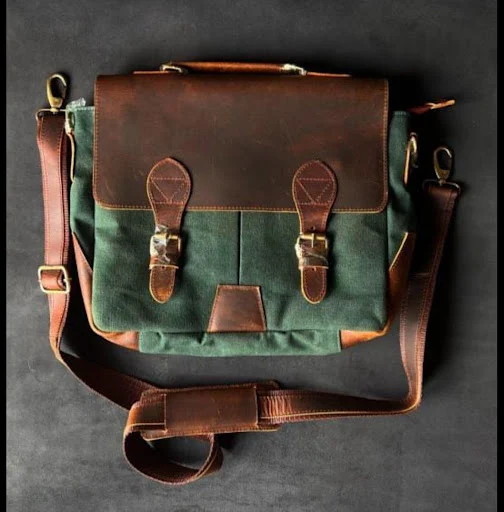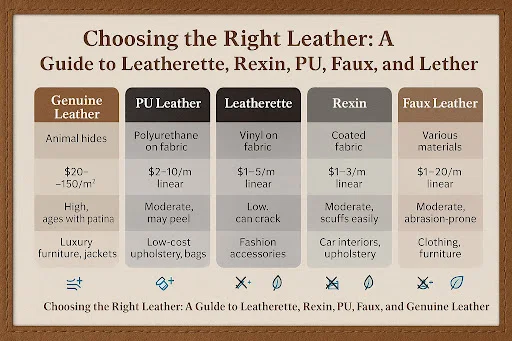Crunch Leather is a unique type of genuine leather recognized for its crinkled, textured appearance and natural glossy finish. Despite what the name might suggest, it isn't hard or "crunchy"—in fact, it's usually supple, soft, and flexible. The term "crunch" refers to the aesthetic finish, which involves crumpling and treating the leather to produce a wrinkled grain pattern that’s both organic and rich in character.
This leather is typically made from top-grain or full-grain cowhide or calfskin, preserving the natural surface of the hide. What makes it visually captivating is the layered dyeing process, which results in two-tone depth—a lighter base color subtly peeking through the darker top color, creating a vintage, aged look right out of the box.
How Crunch Leather Is Made
The production of crunch leather involves a combination of traditional tanning methods and specialized finishing techniques:
1. Tanning
Crunch leather is usually chrome-tanned for softness or vegetable-tanned for a firmer feel. Sometimes, a combination of both methods is used to balance flexibility with structure.
2. Dyeing
Crunch leather typically undergoes a two-layer dyeing process:
-
A base color is applied first, often a neutral or earthy tone.
-
A topcoat dye is then sprayed or applied at an angle, highlighting raised surfaces while leaving creases and valleys with a hint of the base color.
3. Crunching/Boarding
The leather is then crumpled or folded—either manually or via machine—to form the signature wrinkles. These creases become permanent during drying and finishing.
4. Waxing and Polishing
Natural waxes and oils are applied to enhance shine and preserve suppleness. A light glazing may be added to produce the final sheen.
The result is a durable, flexible, and beautifully textured leather with a slightly glossy, broken-in appearance.
Characteristics of Crunch Leather
-
Texture: Crinkled, veined surface with organic, non-uniform patterns.
-
Finish: Semi-gloss to glossy, highlighting peaks and valleys.
-
Color Depth: Two-tone look from layered transparent dyes.
-
Touch: Soft, pliable, waxy to the feel—never stiff or brittle.
-
Aging: Patinas beautifully over time; creases deepen, color enriches.
-
Durability: Strong yet lightweight, resistant to minor scratches and wear.
No two pieces of crunch leather are exactly the same, which adds to its distinctiveness and charm.
Historical Background
The aesthetic and process behind crunch leather draw from traditional leathercraft techniques, such as hot-stuffing, vegetable tanning, and manual boarding. Over time, the finishing evolved into a method that intentionally created a pre-aged look for fashion and utility.
Crunch leather gained traction in the late 20th century, particularly through artisan workshops and Italian tanneries. By the 2000s, it had become a favorite in the fashion world, especially for handbags, belts, and wallets, thanks to its visual richness and touchable texture.
Today, it's produced globally and continues to be a material of choice for brands seeking character-driven, artisan-quality leather.
Common Uses
Crunch leather is used in a wide variety of leather products:
-
Handbags & Totes: Lightweight yet durable, visually striking.
-
Wallets & Belts: Strong grain texture hides wear well, looks better with age.
-
Footwear: Casual boots and sneakers often use crunch leather for a vintage vibe.
-
Accessories: Watch straps, key holders, journal covers.
-
Clothing: Occasionally used for jackets, gloves, or trims in fashion-forward pieces.
-
Home Decor: Sometimes found in bar stools, accent chairs, or vintage-inspired décor.
Its versatility lies in combining durability with a rich aesthetic that enhances over time.
Global Terminology and Variations
The term "crunch leather" is used internationally, but some variations exist:
-
“Crunch Nappa” refers to soft crunch-finished calfskin.
-
“Antique Crunch” may imply deeper tonal contrast or more exaggerated aging.
-
“Glazed Crunch” typically has a shinier surface due to polishing.
-
“Oil Crunch” combines wax/oil pull-up characteristics with crunch texture.
-
“Printed Crunch” uses embossing along with crunching for a more uniform appearance.
While these may vary slightly, they all share the core characteristic: a wrinkled finish with a layered, glossy depth.
Quality and Value Perception
Crunch leather is generally seen as a premium finish, especially when crafted from full-grain hides. Its quality is reflected in:
-
Longevity: With proper care, it lasts for years and gets better with age.
-
Character: No two pieces look alike; each item has a one-of-a-kind texture.
-
Performance: Resistant to scuffs and cracks, highly flexible.
-
Appeal: Offers a handcrafted, luxury feel at both mid-range and high-end price points.
The layered, natural appearance also makes it more forgiving—wear and creases enhance rather than diminish its look.
Environmental Considerations
Crunch leather, like all leather, has environmental trade-offs:
-
Tanning Methods: Vegetable-tanned crunch leather is more eco-friendly than chrome-tanned versions.
-
Natural Finishes: Use of oils and waxes over plastic coatings makes it more biodegradable.
-
Longevity: Its durability and timeless appearance encourage long-term use, reducing fast fashion turnover.
-
Synthetic Alternatives: Some faux crunch leathers mimic the appearance but are often plastic-based and less durable.
For sustainable use, look for vegetable-tanned, responsibly sourced crunch leather, and care for it well to extend its life.
How to Identify Authentic Crunch Leather
To distinguish real crunch leather from imitations:
-
Touch: Supple and warm with a slightly waxy feel—not cold or rubbery.
-
Smell: Natural, leathery scent—not chemical or plastic-like.
-
Visual Texture: Organic, irregular creases—not uniform or printed patterns.
-
Edges: Genuine leather has a fibrous texture; fake leather often has smooth or fabric backing.
-
Water Test (if safe): Real leather darkens slightly when wet; faux leather doesn’t absorb.
Authentic crunch leather feels and ages differently from synthetics or bonded leather—and is easy to recognize once you know what to look for.
Interesting Facts
-
The name “crunch” comes from the finishing process—not the feel.
-
It gets better with time—patinas beautifully, revealing base tones.
-
Some leather goods makers treat crunch leather as a signature material, offering limited-edition color runs.
-
It’s popular in both rugged and luxury markets due to its versatile aesthetics.
-
It’s often favored by leathercrafters because minimal tooling still produces striking results.
Final Thoughts
Crunch leather is a celebration of imperfection and artistry. It blends old-world craftsmanship with modern style, resulting in a leather that’s as tactile as it is visual. Whether you choose it for a wallet, a handbag, or a pair of boots, crunch leather brings something no synthetic can replicate: authenticity, personality, and evolution over time.
If you're looking for leather that tells a story and ages with you, crunch leather might just be the perfect fit.

.png)
%20(970%20x%20600%20px).png)
.png)









